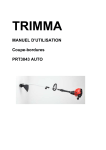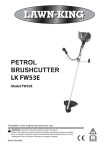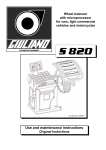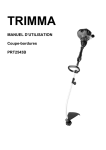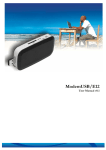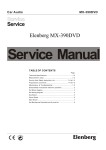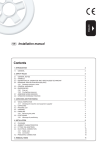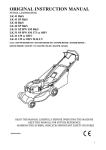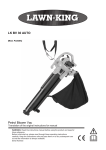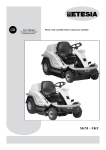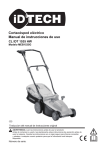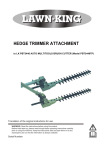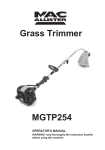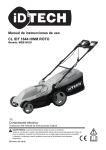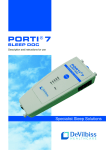Download PETROL TRIMMER
Transcript
PETROL TRIMMER Translation of the original instructions for use WARNING: Read the instructions before using the product Before initial start-up, please read through these operating instructions carefully prior to using the machine. Keep the instructions safe and pass them on to any subsequent user so that the information is always available. Serial Number: 1 Dear Customer, Thank you for choosing one of our products. We hope that you will be completely satisfied with this machine and that it fully meets your expectations. This manual has been compiled in order to provide you with all the information you need to get acquainted with the machine and use it safety and efficiently. Don't forget that it is an integral part of the machine, so keep it handy so that it can be consulted when necessary, and pass it on to a further user if you resell the machine. Your new machine has been designed and manufactured in pursuance with current regu lations, and is safe and reliable if used in compliance with the instructions provided in this manual (proper use). Using the machine in any other way, or non-compliance with the safety specifications relative to use, maintenance and repair is considered "improper use" which will invalidate the warranty, relieve the manufacturer from all habilites, and the user will consequently be liable for all and any damage or injury to him or others. Since we regular improve our products, you may find slight differences between your machine and the descriptions contained in this manual. Modifications can be made to the machine without notice and without the obligation to update the manual, although the essential safety and function characteristics will remain unaltered. In case of any doubts, please contact your dealer. And now enjoy your work! TABLE OF CONTENTS 1. Identification of the main components .......................... 2. Symbols....................................................................... 3. Safety requirements ..................................................... 4. Machine assembly ....................................................... 5. Preparing to work ......................................................... 6. How to start - Use — Stop the engine .......................... 7. Using the machine ....................................................... 8. Maintenance and storage ............................................. 9. Troubleshooting ........................................................... 10. Disposal / Environmental protection ............................. 10. Guarantee.................................................................... 11. Technical data + CE Declaration of Conformity ............. 2 1. IDENTIFICATION OF MAIN COMPONENTS MAIN COMPONENTS 1. Power unit 2. Drive tube 3. Drive tube terminal 4. Cutting line head 5. Cutting device guard 6. Front handle 7. Rear handles with controls CONTROLS AND REFUELLING 21. Engine stop switch 22. Throttle trigger 23. Throttle trigger lockout 24. Spark plug 25. Choke (auto-choke) 26. Primer 31. Fuel tank cap 32. Fuel tank 33. Starter 3 2. SYMBOLS On the equipment, there are information symbols. These convey important information about the product or information about the use. CAUTION: special safety measures are required when handing the unit! The entire operating instructions must be read and understood before use. Non-observance of the operating instructions may be fatal! 1. Maximum rotational frequency of spindle. 2. Attention to cutting devices and thrown objects. 3. Caution! Fuel and fuel fumes are flammable. Risk of fire and explosion! 4. Read the operating instructions carefully before using the equipment! 5. NEVER use cutting blades! ONLY nylon head on this product. 6. Wear eye, ear and head protection. 7. Wear protective gloves. Risk of injury from cuts. 8. Wear safety boots with sturdy soles. 9. Maintain a safety distance of min. 15 m from others. 10. Danger from parts being thrown out! Keep away from other people. 11. Use only nylon head. 4 12. Specification of the guaranteed sound power level LWA in dB. 13. Caution! Hot surfaces – risk of burns! 14. Symbol on the choke lever Lever in cold start position (START) Lever in warm start position (RUN) 15. Symbol of fuel pump: press the fuel pump 10x before starting. 16. Mix ratio 40:1, use ONLY fuel mix. 17. Conforms to current standards. 5 3. SAFETY REQUIREMENTS A) TRAINING 1) Read the instructions carefully. Become acquainted with the controls and the proper use of the machine. Learn how to stop the engine quickly. 2) Only use the machine for the purpose for which it was designed, namely - cutting grass and non-woody vegetation, using a nylon line (e.g. around the edges of lawns, flowerbeds, walls, fences and small grassy areas to tidy up the cutting done using a mower); Any other use may be dangerous and damage the machine. 3) Never allow children or persons unfamiliar with these instructions to use the machine. Local regulations can restrict the age of the user. 4) The machine must never be used by more than one person. 5) Never use the machine: - When people, especially children or pets are in the vicinity; - if the user is tired or unwell, or has taken medicine, drugs, alcohol or any substances which may slow his reflexes and compromise his judgment; - If the user is not capable of holding the machine firmly with two hands and/or remaining standing on the ground whilst working. 6) Keep in mind that the operator or user is responsible for accidents or hazards occurring to other people or their property. B) PREPARATION 1) Always wear adequate clothing which does not hamper movements when using the machine. - Always wear slim-fitting protective clothing, fitted with shear-proof protection devices. - Always wear a helmet, protective gloves, eye goggles, a half-mask respirator and safety anti shear boots with non-slip soles. - Always wear ear and hearing protection devices. - Never wear scarves, shirts, necklaces, or any hanging or flapping accessory that could catch in the machine or in any objects or materials in the work area. - Tie your hair back if it is long. 6 2) WARNING: DANGER! Petrol is highly flammable: - keep the fuel in containers which have been specifically manufactured and homologated for such use; - Never smoke when handling fuel; - Slowly open the fuel tank to allow the pressure inside to decrease gradually; - Top up the tank with fuel in the open air, using funnel; - add fuel before starting the engine. Never remove the fuel tank cap or add fuel while the (engine is running or when the engine is hot; - if you have spilt some fuel, do not attempt to start the engine but move the machine away) from the area of spillage and avoid creating an) source of ignition until the fuel has evaporated and fuel vapors have dissipated; - Immediately clean up all traces of fuel spilt or the machine or on the ground; - Never start the machine in the same place you refilled it with fuel; - make sure your clothing does not come into contact with the fuel, on the contrary, change your clothes before starting the engine; - Always put the tank and fuel container cap: back on and tighten well. 3) Replace faulty or damaged silencers. 4) Before using the machine, check its general condition and in particular: - The throttle trigger and the safety lever must move freely, they must not need forcing an should return automatically and rapidly back to the neutral position; - The throttle trigger must remain locked until the safety lever is pressed; - The engine stop switch must easily move from one position to the other; - the electric cables and in particular the spark plug cable must be in perfect condition to avoid the generation of any sparks, and the cap must be correctly fitted on the spark plug; - The machine handgrips and protection devices must be clean and dry and well fastened to the machine; - The cutting devices and guards must be undamaged. 5) Check the correct position of the handgrip: and the connection point of the webbing, and the proper balance of the machine. 6) Thoroughly inspect the whole work area and remove anything that could be thrown up by the machine or damage the cutting group or engine (stones, branches, iron wire, bones, etc.). 7 C) OPERATION 1) Do not start the engine in a confined space where dangerous carbon monoxide fumes car collect. 2) Mow only in daylight or good artificial light. 3) Take on a firm and well-balanced position: - Where possible, avoid working on wet, slippery ground or in any case on uneven or steel ground that does not guarantee stability for the operator; - Never run, but walk carefully paying attention to the lay of the land and any eventual obstacles; - assess the potential risks of the ground to be mown and take all necessary precautions to ensure your own safety, especially on slopes or on bumpy, slippery or unstable ground; - work along the contour on slopes, never when walking up or down and always keep downhill of the cutter. 4) make sure the machine is securely locked when you start the engine: - start the motor in an area at least 9 meters from where you refueled; - check that there is nobody within at least 15 meters of the machine's range of action; - do not direct the silencer and therefore the exhaust fumes towards inflammable materials. 5) Do not change the engine governor settings or over speed the engine. 6) Do not strain the machine too much and do not use a small machine for heavy-duty works. If you use the right machine, you will reduce the risk of hazards and improve the quality of your work. 7) Check that when the machine is running idle, there is no movement of the cutting device and, alter pressing the throttle trigger, the engine quickly returns to minimum speed. 8) Stop the engine: - Whenever you leave the machine unattended. - Before refueling. - During movements between work areas. 9) Stop the engine and disconnect the spark plug cable: - Before cleaning, checking or working on the machine; - After striking a foreign object. Inspect the machine for any damage and make repairs before restarting it again; 8 - If the machine starts to vibrate abnormally: find and remove the cause of the vibration immediately; - When the machine is not in use. D) MAINTENANCE AND STORAGE 1) Keep all nuts, bolts and screws tight to be sure the equipment is in safe working condition. Routine maintenance is essential for safety and for maintaining a high performance level. 2) Do not store the machine with fuel in the tank in an area where the fuel vapors could reach an open flame, a spark or a strong heat source. 3) Allow the engine to cool before storing in any enclosure. 4) To reduce fire hazards, keep the engine, exhaust silencer and fuel storage area free from sawdust, branches, leaves, or excessive grease; never leave containers with the cut debris inside the storage area. 5) If the fuel tank has to be emptied, this should be done outdoors once the engine has cooled down. 6) Always wear protective gloves when handling the cutting device. 7) For safety reasons, never use the machine with worn or damaged parts. Damaged parts are to be replaced and never repaired. Only use original spare parts. Parts that are not of the same quality can seriously damage the equipment and compromise safety. The cutting tools must always bear the manufacturer's trademark as well as a reference to the maximum working speed. 8) Before putting the machine away, check you have removed wrenches or tools used for maintenance. 9) Store the machine out of the reach of children! E) TRANSPORTATION AND HANDLING 1) Whenever the machine is to be handled or transported you must: - turn off the engine, wait for the cutting device to stop and disconnect the spark plug cap; - Only hold the machine using the handles and position the cutting device in the opposite direction to that used during operation. 2) When using a vehicle to transport the machine, position it so that it can cause no danger to persons and fasten it firmly in place to avoid it from tipping over, which may cause damage or fuel spillage. 9 F) HOW TO READ THE MANUAL Certain paragraphs in the manual contain particularity significant information and are marked with various levels of highlighting with the following meaning: NOTE Or IMPORTANT These give details or further information on what has already been said, in the aim to prevent damage to the machine. WARNING! Non-observance will result in the risk of injury to oneself or others. DANGER! Non-observance will result in the risk of serious injury or death to oneself or others. 10 4. MACHINE ASSEMBLY IMPORTANT The machine is supplied with some of the components disassembled and the fuel tank empty. WARNING! Mount the components very carefully so as slot to impair the safety and efficiency of the machine. If in doubt, contact your dealer. A. ASSEMBLING OF SPLIT SHAFT 1. Unscrew the coupling knob. 2. Insert the lower transmission tube by sliding it inside the upper transmission one. 3. As per the insertion, slightly rotate the lower tube on the right and on the left until the internal transmission shaft snaps into place. 4. The tubes are connected properly when the ball lock is in its housing. 5. Tighten now the coupling knob to lock the shaft. B. ASSEMBLING OF HANDGRIP Position the handgrip, as shown, between the stop against the handgrip and the coupling knob, and clip it. Tighten the screw and the nut, so to fix the handgrip. 11 C. ASSEMBLING OF PLASTIC GUARD AND OF LINE CUTTER Unscrew the plastic guard. Slide the plastic guard along the lower transmission shaft, up to the « U » part, provided for this purpose. Place the plastic guard on the « U » aligning its holes with those of the « U » part. Tighten the screw and tighten the plastic guard on the transmission shaft, so that it cannot come loose during use, due to vibrations. Once the plastic guard in place, remove the plastic cover from the line cutter, which is located underneath the guard. D. ATTACHING AND DETACHING OF RETAINING STRAP Be equipped with a retaining strap. Adjust the length and the width of the strap so to obtain a comfortable position. Hook or unhook the clasp of the strap at the attachment ring provided on the shaft. 12 5. PREPARING TO WORK CHECKING THE MACHINE Before starting work please: - Check that ail the screws on the machine and the cutting device are tightly fastened; - check that the air filter is clean; - check that the protection devices are well fastened and working efficiently; - check the handgrips are well fastened. PREPARING THE FUEL This machine is fitted with a two-stroke engine which requires a mixture of petrol and lubricating oil. IMPORTANT Using petrol alone will damage the motor and will cause for invalidation of the warranty. IMPORTANT Only use quality fuels and oils to maintain high performance and guarantee the duration of the mechanical parts over time. Petrol characteristics Only use unleaded petrol with a fuel grade of at least 91 N.O. IMPORTANT Unleaded petrol tends to create deposits in the container if preserved for more than 2 months. Always use fresh petrol! Oil characteristics Only use top quality synthetic oil specifically for two-stroke engines. Your dealer can provide you with oils which have been specifically developed for this type of engine, and which are capable of guaranteeing a high level of protection. 13 For synthetic oil, add 2, 5% oil to gasoline (refer to indications of oil), it means 2, 5 cl of oil per 100 cl petrol. Preparation and preservation of the fuel mixture DANGER! Petrol and the fuel mixture are highly inflammable! - Keep the petrol and fuel mixture in homologated fuel containers, in safe place, away from any flames or heat sources. - Never leave the containers within the reach of children. - Never smoke whilst preparing the mixture and avoid inhaling the petrol fumes. To prepare the fuel mixture: - Place about half the amount of petrol in a homologated tank. - Add ail the oil, according to the above indication. - Add the rest of the petrol. - Close the top and shake well. IMPORTANT The fuel mixture tends to age. Do not prepare excessive amounts of the fuel mixture to avoid deposits from forming. IMPORTANT Keep the petrol and fuel mixture containers separate and easily identifiable to avoid the mistake of using one in place of the other. IMPORTANT Periodically clean the petrol and fuel mixture containers to remove any eventual deposits. REFUELLING 14 DANGER! Never smoke whilst refueling and avoid inhaling the petrol fumes. WARNING! Carefully open the tank top as pressure could have formed inside. Before refueling: Shake the fuel mixture container well. Place the machine on a flat stable surface, with the fuel tank cap facing upwards. Clean the fuel tank cap and the surrounding area to avoid any dirt from entering the tank during refilling. Carefully open the fuel tank cap to allow the pressure inside to decrease gradually. Use a funnel to refill and avoid filling the tank to the brim. WARNING always closes the fuel tank firmly. WARNING! Immediately clean all traces of fuel which may have dripped on the machine or the ground and do not starts the engine until the petrol fumes have dissipated. 15 6. HOW TO START - USE - STOP THE ENGINE STARTING THE ENGINE WARNING! The engine must be started in an area at least 3 meters from where you refilled the fuel tank. Before starting the engine: - ensure that the protective cap on the line cutter has been removed. - Place the machine firmly on the ground. NOTE To avoid overloading the engine upon ignition, make sure that the cutting line head nylon wire is not over 13 cm long. IMPORTANT To avoid breaking the starter rope, do not pull the whole length of it or let it slide along the edge of the cable guide hole. Release the starter gradually, to avoid letting it fly back uncontrollably. WARNING! Starting the engine with the starter engaged causes the cutting device to move, only stopping when the starter is disconnected. Starting the Engine (Picture 10): Start the engine at least 3 meters from the filling location Ensure that the protective cap on the line cutter has been removed. 1. Fuel • Level the engine before fueling. • Open the fuel tank cap and fill the fuel tank with 40:1 gas/oil-mixed fuel. 16 • Pour slowly to avoid splash back and allow air to escape from the fuel tank. • Close the tank cap securely by turning it clockwise as far as it will do. Warning! Never fill the tank so the fuel level rises into the filler neck. If the tank is overfilled, heat may cause the fuel to expand and overflow through the vents in the tank cap. After refueling, make sure the fuel tank cap is closed securely. If gasoline is spilled on the fuel tank, wipe it off immediately. Danger! Exhaust gases contain carbon monoxide, a colorless, odorless, poisonous gas. Do not operate the engine in enclosed areas. Provide adequate ventilation at all time. 2. Set the On/Off switch on the switching element. 3. Move the throttle lever on the equipment to START (engine idle speed) position. 4. Slowly push the priming pump several times until the fuel comes out of the overflow tube. 5. Choke lever type: Move the choke lever to the “START” position. When the engine is already warm up, set the choke lever to the “RUN” position. 17 6. Hold the equipment firmly with one hand on the shaft tube. With the other hand, pull the starter cable several times on the starter handle until the engine starts. Pull the recoil starter grip slowly to engage the starter, and then give a short, quick pull. Caution! Do not pull the starter cable out too far – risk of breaking! Warning! Releasing the starting rope suddenly may allow the rope to whip around and cause injury and/or damage the recoil starting mechanism. When starting the engine, firmly grasp the recoil starter grip; do not grasp the starter rope itself. Always control the rope as it rewinds into the housing. Note: • Should the engine fail to start, do not try the recoil start many times with the choke lever to the “START” position. This will cause the fuel to flood into the cylinder and make starting even more difficult. In this case, set the choke lever to the “RUN” position. And then, repeat the starting. • After starting, vary the engine speed a few times, by operating the throttle lever to draw out the remaining air in the carburetor. 7. Warming up After starting the engine, run the engine at the idling speed (throttle lever position is fully CLOSED) for a few minutes. Notice: Allow sufficient warm-up time to prevent engine damage and run the engine smoothly. The engine should be run at idle speed for a few minutes to allow it to warm up before applying a load. This will allow oil to reach engine parts, and allow piston clearance to reach design specifications. 18 8. Adjusting Fuel adjustment The carburetor has been adjusted to the optimum fuel supply at the factory. Don’t reset the carburetor setting. Note: If adjustment is needed, if should be performed by your authorized dealer. 10. Attach the equipment to the shoulder strap that has been put on (see chapter on “Putting on the Shoulder Strap”). 11. To mow, hold the throttle lock depressed and operate the throttle. 12. STOPPING • Move the throttle lever on the equipment to the fully CLOSED (engine idle speed) position, and the engine running at idle speed. • Turn the engine switch to the “O” (stopping) position. Notice: Suddenly stopping engine from high speed operation can cause engine damage. Reduce engine speed to idle speed to idle speed for one minute before shutting engine off after highspeed, Emergency stop Turn the engine switch to the “O” (stopping) position. Working Notes • When cutting, observe the country specific / local regulations. • Do not cut during commonly applicable quiet periods. • Solid objects such as stones, metal pieces or similar must be removed. These can be thrown out and therefore result in personal or property damage. • When cutting in high bushes or hedges, the working height should be at least 15 cm. This prevents the risk to animals, e.g. hedgehogs. Work safely and considerately! • Always hold the equipment firmly and securely with both hands. • Cut only grass and weeds. Be aware of roots or tree stumps – risk of tripping. • Work considerately and endanger nobody when cutting. Work quietly and carefully. • Work only in adequate visibility and lighting conditions. 19 • Keep an eye on the cutting head. • Never cut above shoulder height. • Never replace the plastic cord with a steel wire – risk of injury and damage. • Do not work on a ladder. • Work only on firm and stable bases. • Always carry the equipment suspended by the shoulder strap or on the tube. Working with the nylon head • On small grass areas, hold the equipment at an angle of approx. 30° and turn evenly to the right and left with a semi-circular movement. • The best results are obtained with maximum grass length of 15 cm. If the grass is longer, mowing several times is recommended. • To cut around trees, fence posts or other obstacles, go slowly around the obstacle with the equipment and cut with the tips of the cutting line. • Avoid contact with solid obstacles (stones, walls, board fences etc) otherwise the line will quickly wear out. Use the edge of the plastic protection guard to keep the equipment at the correct distance. Caution! Do not place the cutting head on the ground during operation! Extending the cutting line The equipment comes with a double line tap feed mechanism, i.e. both lines extend if the nylon head is tapped on the ground. 1. Hold the equipment in operation over a grassy area and lightly tap the nylon head a few times on the ground. This extends the line. 2. The line cutter, included in the plastic guard, cuts the line to the desired length. If the line ends no longer extend: • Switch off the equipment. • Press the reel insert until it stops and give a strong pull on the thread end. If no thread ends are visible: If no thread ends are visible: • Inspect and if necessary replace the line or cutting line spool (see chapter on changing the spool). Caution! Line remnants may be thrown out and cause injuries. 20 7. USING THE MACHINE To respect people and the environment: - Try not to cause any disturbance. - Scrupulously comply with local regulations and provisions for the disposal of waste materials alter sawing. - Scrupulously comply with local regulations and provisions for the disposal of oils, petrol, damaged parts or any elements which have a strong impact on the environment. WARNING! Prolonged exposure to vibrations can cause injuries and neurovascular disorders (also called "Renaud’s syndrome" or "white hand"), especially to people suffering from circulation disorders. The symptoms can regard the hands, wrists and fingers and are shown through loss of sensitivity, torpor, itching, pain and discoloring of or structural changes to the skin. These effects can be worsened by low ambient temperatures and/or by gripping the handgrips excessively tightly. If the symptoms occur, the length of time the machine is used must be reduced and a doctor consulted. WARNING! Always wear suitable clothing when using the machine. Your dealer can provide you with all the information on the most suitable accident-prevention devices to guarantee your safety. USING THE MACHINE WARNING! When working, the machine must always be firmly held in both hands, keeping the power unit on the right of the body and the cutting group below the line of the belt. Before tackling a mowing job for the first time it is advisable to gain the necessary familiarity with the machine and the most suitable cutting techniques, finding out how to firmly grip the machine and making the movements required by the job. The cutting line head can eliminate tall grass and non-woody vegetation near fences, walls, foundations, pavements, around trees, etc. or to completely clean a particular area of the garden; 21 WARNING! The use of metal or rigid blades of any type with this machine is prohibited. WORKING TECHNIQUES WARNING! Use ONLY nylon lines. The use of metal lines plasticized metal lines and/or lines not suitable for the head can cause serious injuries and wounds. During use it is advisable to stop the engine periodically and remove the weeds wound round the machine, so as to prevent the drive tube from overheating due to the grass caught under the guard. Remove the caught-up grass with a screwdriver to allow the rod to be properly cooled. WARNING! Do not use the machine for sweeping, tilting the cutting fine head. The power of the engine could throw objects and mail stones 15 meters or more, causing damage and injuries to people. Cutting in motion (Scything) Proceed at a regular pace, with a circular motion similar to a traditional scythe, without tilting the cutting line head during the operation. First try cutting at the right height in a small area, so as to then achieve a uniform cutting height keeping the cutting line head at a constant distance from the ground. For heavier cutting it can be useful to tilt the cutting line head by about 30°. WARNING! Do not work in this way if there is the possibility of causing objects to be thrown, which could harm people and animals and cause damage. Precision cutting (Trimming) Keep the machine slightly tilted so that the lower part of the cutting line head does not touch the ground and the cutting line is at the required point, always keeping the cutting device at a distance from the operator. 22 Cutting near fences / foundations Slowly approach the cutting line head to fences, posts, rocks, walls, etc. without hitting them hard. If the line strikes a solid object it could break or become worn; if it gets tangled in a fence it could break abruptly. In any case, cutting around pavements, foundations, walls, etc. can cause greater wear than normal in the line. Cutting round trees Walk round the tree from left to right, approaching the trunks slowly so as not to strike the tree with the line and keeping the cutting line head tilted forward slightly. Remember that the nylon line could lop or damage small shrubs and that the impact of the nylon line against the trunk of bushes or trees with soft bark could seriously damage the plant. 23 8. MAINTENANCE AND STORAGE Correct maintenance is essential to maintain the original efficiency and safety of the machine over time. WARNING! During maintenance operations: - Remove the spark plug cap. - Wait until the engine is sufficiently cold. - Never dispose of oils, fuel or other polluting materials in unauthorized places. CYLINDER AND SILENCER To reduce fire risks, periodically clean the cylinder flaps with compressed air and clear the silencer area to get rid of sawdust, branches, leaves or other debris. STARTING SYSTEM To avoid overheating and damage to the engine, always keep the cooling air vents clean and free of sawdust and debris. The starter rope must be replaced as soon as it shows signs of wear. NUTS AND SCREWS Periodically check that all the nuts and screws are securely tightened and the handgrips are tightly fastened. CLEANING THE AIR FILTER IMPORTANT Cleaning the air filter is essential to guarantee the efficiency and duration of the machine. Do not work with a damaged filter or without a filter, as this could permanently damage the engine. It must be cleaned alter every 8-10 working hours. Clean the filter as follows: - Wash the filter element with soap and water. Do not use petrol or other solvents. 24 - Leave the filter to dry in the open air. - Fit the filter element and the cover back on. CHECKING THE SPARK PLUG Periodically remove and clean the spark plug using a metal brush to get rid of any deposits. Check and reset the correct distance between the electrodes. Replace the spark plug and fasten it firmly using the supplied wrench. The spark plug must be replaced with one with the same characteristics whenever the electrodes have burnt or the insulation has worn, and in any case every 100 working hours. TUNING THE CARBURETTOR The carburetor is tuned by the manufacturer to achieve maximum performance in all situations, with a minimum emission of toxic gas in compliance with the regulations in force. In the case of poor performance contact your Dealer for a check of the carburetion and engine. 25 HEAD LINE REPLACEMENT Follow the instructions for replacing the nylon line. 1- Firmly hold the body of the cutting head and unscrew the bumper cover. 2- Remove the empty spool. Remove the line remaining on the spool. 3- Remove the spring. 4- Clean the interior of the spool body carefully. 5- Take a length of 5,40 m nylon line of 2,4 mm diameter or less, in special plastic, suitable for trimmer and fold into two equal length (2,70 m each). 6- Place the two pieces of the nylon lines in the central interstice of the spool, designed for this purpose. 7- Wrap, in the direction of clockwise (follow the direction of the arrow “Wincord” engraved on the spool), the 2 nylon lines in their respective compartments. 8- Fix the 2 ends into two of the 6 notches of the lower flange of the spool, leaving about 150 mm beyond the slot. NB: The notches are of different sizes to better fix the nylon line in function to its diameter. ATTENTION: Once engaged, the lines must be diametrically opposite, i.e. face to face. 9- Put again the spring in place on the spool filled. 10- Pass each line into an eyelet of the cutting head and pull on each line alternatively, while maintaining pressure on the nylon spool. 11- Put again the bumper cover and screw. Be sure that the cover is properly closed. 26 SHARPENING THE LINE CUTTER - Unscrew the two nuts and remove the line cutting knife from the guard. - Let sharpen the cutting knife an authorized Service Workshop. - Refit the knife on the guard. EXTRAORDINARY MAINTENANCE Ail maintenance operations not foreseen in this manual must be performed exclusively by your dealer. Ail and any operations performed in unauthorized centers or by unqualified persons will totally invalidate the warranty. STORAGE After every work stint, clean the machine thoroughly to remove all dust and debris, and repair or replace any faulty parts. The machine must be stored in a dry place away from the elements. LONG PERIODS OF DISUSE IMPORTANT If you are not going to use the machine for a period of more than 2-3 months, we recommend you do a few things before putting it away. This will make it easier when you want to use the machine again and will also prevent permanent damage to the engine. Storage Before putting the machine away: - Empty the fuel tank. - Start the engine and run it idle until it comes to a halt, so that it uses up all the fuel that is left in the carburetor. - Wait for the engine to cool down and remove the spark plug - Pour a teaspoon of fresh oil into the spark plug hole. - Pull the starter rope several times to deliver oil to the cylinder. - Replace the spark plug with the piston in the dead end upper position (visible from the spark plug slot when the piston is at maximum stroke). 27 Restarting work When you wish to start using the machine again: - Remove the spark plug. - Pull the starter rope a few times to eliminate excess oil. - Check the spark plug as described in chapter "Checking the spark plug". - Prepare the machine as indicated in the paragraph entitled "Preparing for work". 28 9. TROUBLESHOOTING PROBLEM 1) The engine will not start or will not keep running LIKELY CAUSE Incorrect starting procedure Dirty spark plug or incorrect distance between the electrodes SOLUTION Follow the instructions Check the spark plug Clean and/or replace the filter Contact your dealer Air filter clogged Carburetion problems 2) The engine starts but is lacking in power Air filter clogged Carburetion problems 3) The engine runs irregularly and lacks in power when rewed Dirty spark plug or The engine gives off an excessive amount of smoke Incorrect composition of 4) incorrect distance between the electrodes Carburetion problems the fuel mixture Carburetion problems Clean and/or replace the filter Contact your dealer Check the spark plug Contact your dealer Prepare the fuel mixture according to the instructions Contact your dealer 29 10. DISPOSAL / ENVIRONMENTAL PROTECTION Machinery does not belong in domestic waste. Do not allow used oil and petrol residues into the sewer system or drains. Dispose of used oil and petrol residues in an environmentally friendly way – take them to a disposal point. Take the equipment, accessories and packaging for environmentally friendly recycling. Drain the petrol tank carefully and take your equipment to a recycling point. The plastic and metal components used can be separated by type and therefore recycled. GUARANTEE • We guarantee this equipment for 24 months. • The guarantee does not cover damage caused by natural wear, overloading or improper use. Certain components are subject to normal wear and not covered by the guarantee. These specifically include the: metal cutting blade, cutting line spool, cutting line, line cutter, air filter and spark plug, etc. • The guarantee is also conditional on adherence to the instructions on cleaning and maintenance. • Please keep your receipt as proof of purchase. • Please always get in contact with our Customer Service to check all the specific conditions of the guarantee of this product. 30 11. TECHNICAL SPECIFICATIONS Engine ...................................................................................................... 2-stroke air-cooled Capacity / Power ...................................................................................... 29.7 cm 3 / 0.76 kW Engine rotation speed at tick-over ........................................................................ 11000 min-1 Maximum engine rotation speed ........................................................................... 11000 min-1 Maximum tool rotation speed ................................................................................ 11000 min-1 Mixture ................................................................................ Petrol: 2-stroke oil = 40:1=2,5 % Tank capacity ............................................................................................................. 600cm3 Weight 1) ...................................................................................................................... 5.3 kg PHONOMETRIC RECORDINGS AND VIBRATIONS Vibrations level (as per ISO 22867) ..................................................................... 7, 7 m/s2 Incertainty of measurement of vibrations .................................................................... K: 3.1 m/s² Sound pressure level (as per ISO 22868) : .......................................................... LPA : 100 dB(A) Sound power level measured (as per ISO 10884) : ............................................ LWA : 108 dB(A) Sound power level guaranteed: ......................................................................... LWA: 113 dB (A) Incertainty of measurement of sound power levels: ................................................... K= 1 dB (A) 31 EC DECLARATION OF CONFORMITY Serial number : pls see front page We,company, GARDIF 60 AVE DE BRUXELLES Z.A. DE L’EUROPE 77310 PONTHIERRY FRANCE The undersigner, Bruno VAN ELSLANDE, Managing Director, Declare that the product PETROL TRIMMER: LAWNKING models LK PRT3043 AUTO – ref. CBT911251 (MODEL PRT3043) Complies with the essential health and safety requirements of the following directives: - The Machinery Directive 2006/42/EC - The EMC Directive 2004/108/EC - The Noise Directive 2000/14/EC & 2005/88/EC - The Directive Emissions 97/68/EC&2002/88/EC&2004/26/EC The conformity assessment followed was according to Directive 2000/14/EC, Annex V, and the Directive 2005/88/EC. Measured Sound Power Level: 108 dB(A) Guaranteed Sound Power Level: 113 dB(A) Made in Ponthierry (France), 2013.12.11 B. VAN ELSLANDE, Managing Director
































